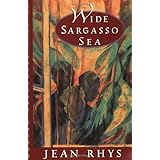
Average Reviews:

(More customer reviews)Jean Rhys, the troubled author who was far ahead of her time in the 1920's, felt a strange kinship with Antoinette or Bertha Mason, the madwoman locked in the attic in Bronte's "Jane Eyre." From the first time Rhys read "Jane Eyre" she knew she would someday write her story because she felt she'd lived it.
Like Antoinette, Rhys grew up in the Caribbean, a troubled and hermetic world of Creoles, colonists and former slaves. Antoinette is truly a loner--the reversal of family fortunes causes her to be rejected by her own people, and despised by those who previously were on a lower rung of society. Throughout the novel, Antoinette is used, buffeted and never in charge of her own life. She feels that, as a woman, she is an object, not a person. As a woman, she is not in charge of her ultimate destiny, and this provides the conflict for the novel. Her madness is only an extension of this isolation and rejection.
What makes Rhys a masterful novelist is her use of conversation and immediate events to describe the world in which Antoinette lives. There are no long passages of exposition; we see the world only through the eyes of the characters, mostly at the same time that they experience it. However, the immediate events and conversation or narration are so cleverly constructed that the reader sees through the narrator's eyes and can really see and feel the surroundings. This intimate point of view puts the reader in the skin of the character, but can be a bit confusing because we cannot always rely on the veracity of the narration. The point of view itself switches in the novel from first person to third person, in the second part, and back to first in the third and final portion, where Antoinette is locked in the attic.
The novel is in no way a re-write or version of "Jane Eyre." In "Jane Eyre", the madwoman is not really a character--she's a symbol for evil, for carnal and worldly desires yielded to without regard for the soul. "Wide Sargasso Sea" develops the madwoman into a character. Rhys slyly copies the beautiful symmetry of "Jane Eyre", where events occur in a sort of repetition; in "Jane Eyre", the heroine must leave a hostile home and find a haven, which then becomes hostile because it fails to nourish her soul with love (Gateshead, Lowood, Thornfield and then Marsh House. Only when Jane can marry her Mr. Rochester on HER terms, does she find a true home.) In "Wide Sargasso Sea", Antoinette's home burns twice, a similar use of symbolism, here representing rejection by the world.
"Wide Sargasso Sea" is often listed as a "must-read" book --it certainly is a unique book and was far ahead of its time when Rhys wrote it. It's really worth reading.
Click Here to see more reviews about: Wide Sargasso Sea: A Novel
Click here for more information about Wide Sargasso Sea: A Novel

No comments:
Post a Comment